How To Grow Strawberries: The Definitive Guide
Get started growing strawberries with all the expert advice you need for a delicious crop – from plant care basics to troubleshooting common problems.
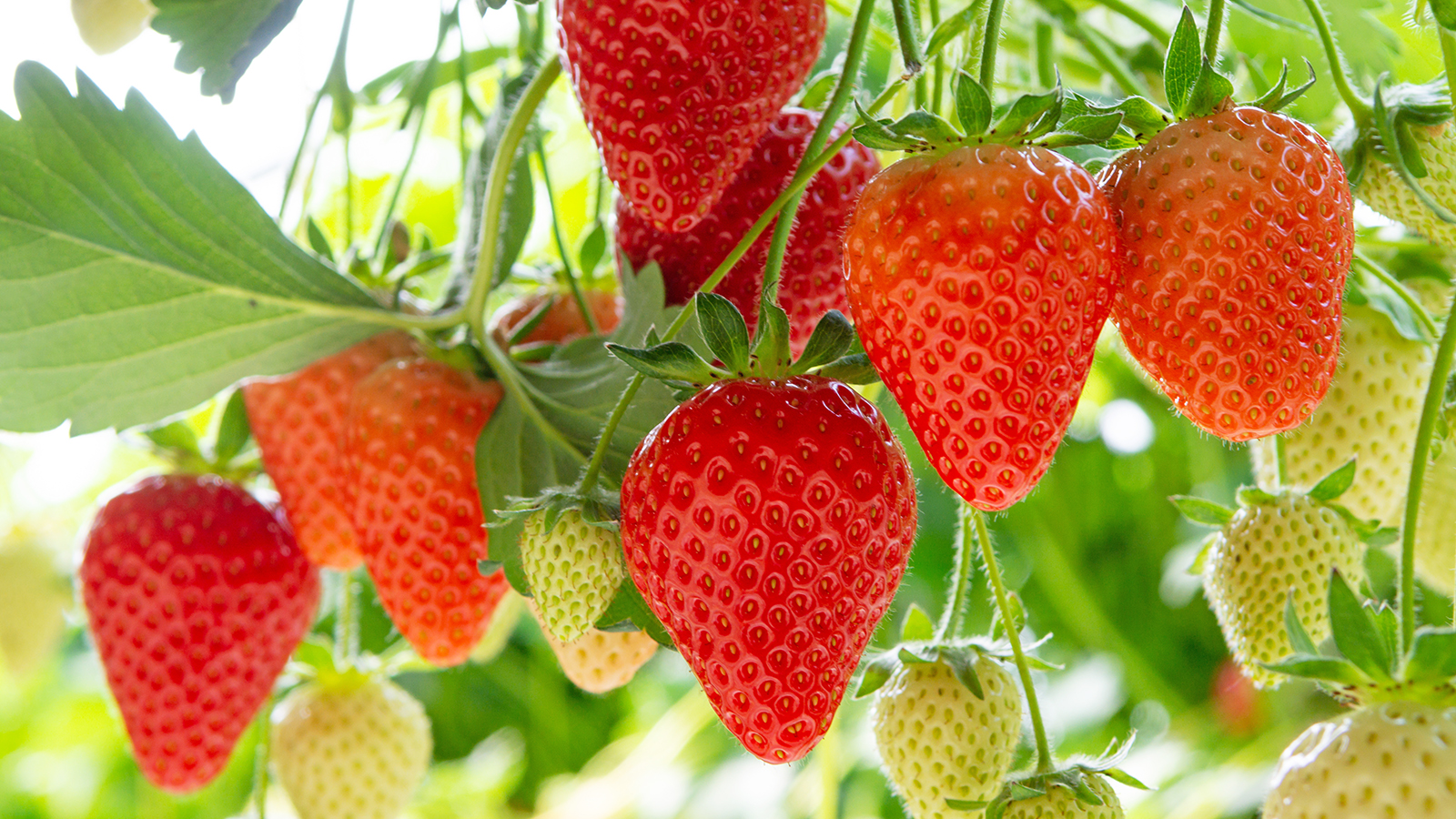

Learning how to grow strawberries is such a rewarding way to grow your own food. Truly, nothing in this world tastes better than a perfectly ripe strawberry picked straight from the plant.
Strawberries are among the easiest fruits to grow, but you do need a little know-how to get the best possible crops.
Follow the basic rules of growing strawberries, and you will enjoy a bountiful harvest from spring to fall.
Which Types of Strawberries?
Your first step is to choose which strawberry varieties to grow. There are three main types of strawberry plants to consider:
- June-bearing strawberries, which produce one strong, sweet and juicy crop between spring and early summer. Notable varieties include include Allstar, Annapolis, Camarosa, Earliglow, Gariguette, Honeoye, Kent, Northeaster, Purple Wonder, Sequoia, Surecrop, and Tillamook.
- Everbearing strawberries, which will produce fruit from summer to fall, usually in two crops with a gap in between. Consider trying Everest, Fort Laramie, Jewel, Ozark Beauty, Quinault, Tribute, and Tristar.
- Day-neutral strawberries, which produce large, firm fruits from summer into fall. Popular varieties include Albion, Aromas, Elsanta, Evie-2, Monterey, Portola, San Andreas, and Seascape.
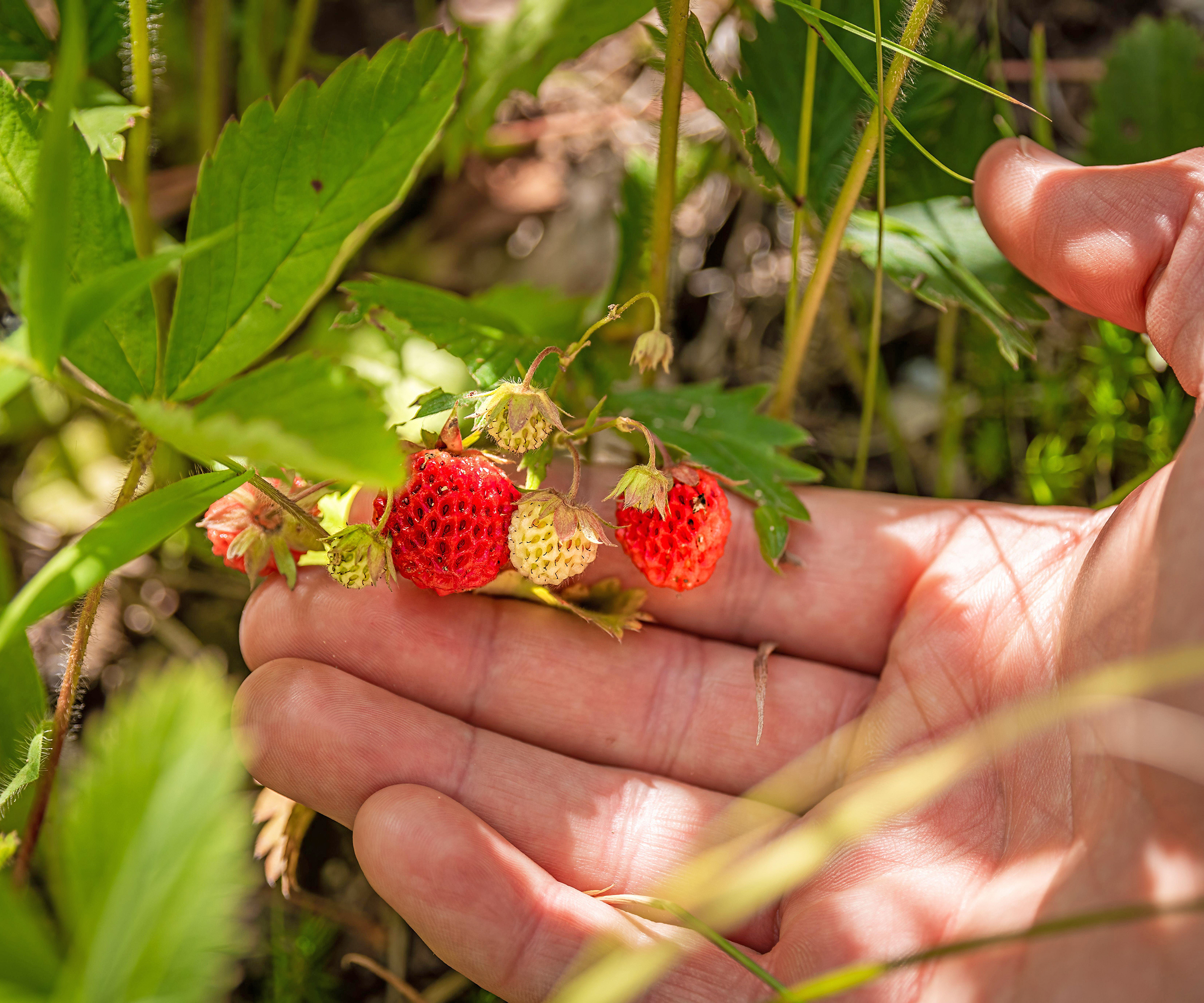
In addition to the three main types, you can also grow wild strawberries, which produce small but sweet berries, and make good edging plants and ground cover.
Alpine strawberries are a popular type of wild strawberry to grow, with delicious varieties including Mignonette and Red Wonder. Unlike other types of strawberries, alpine strawberries don’t usually produce runners and so must be grown from seed.
As flavor and cropping time vary so much, it’s a good idea to plant multiple varieties to keep you in stock of strawberries from late spring to early fall.
Sign up for the Gardening Know How newsletter today and receive a free copy of our e-book "How to Grow Delicious Tomatoes".
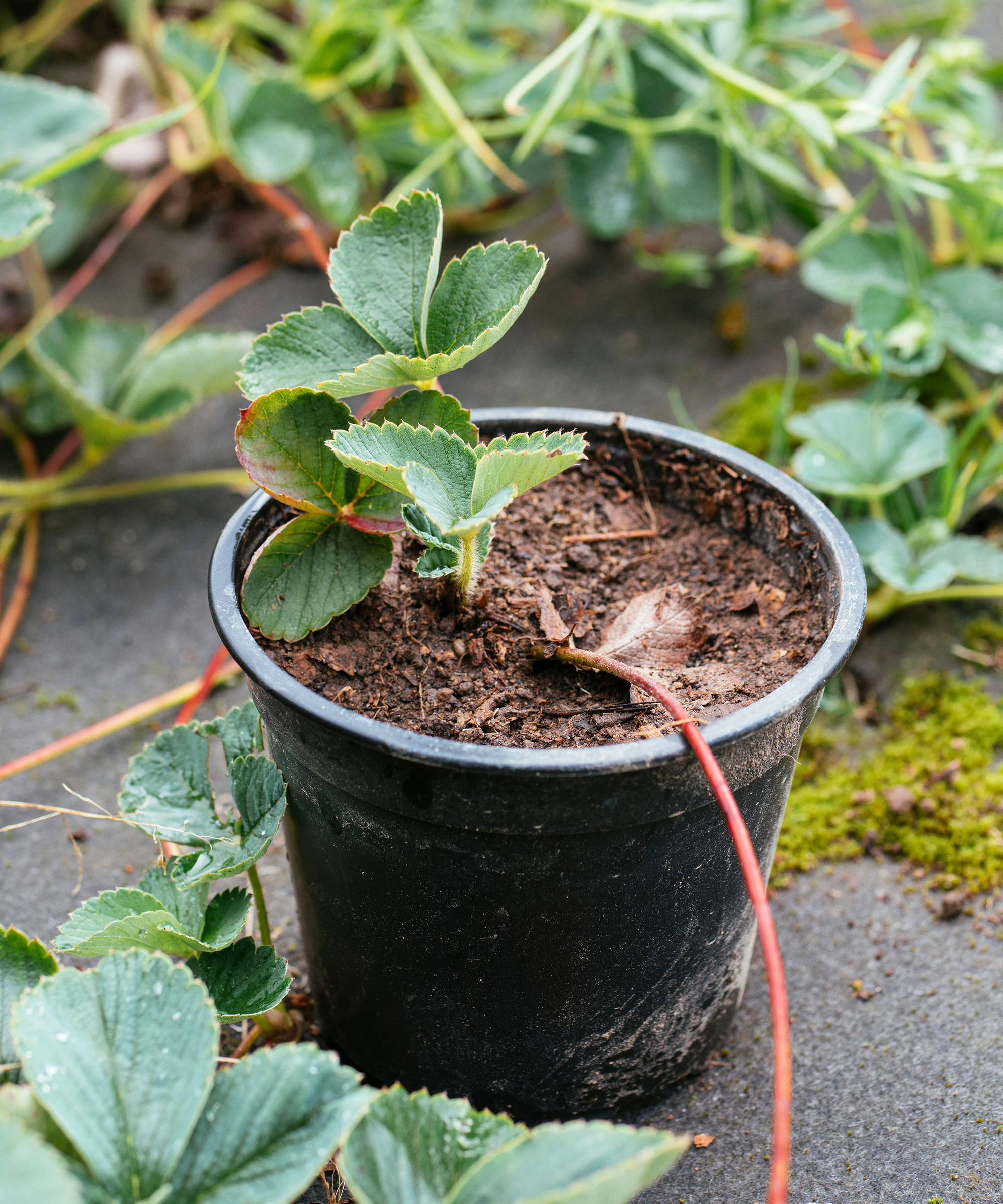
Strawberry Plants Or Seeds?
When deciding how to grow strawberry plants, it's tempting to start from scratch with seed. However, the best way to grow strawberries is to plant young plug plants or bare-root strawberries – also known as runners.
Young plants will produce fruit the summer after they are planted, making it a quicker route than growing from seed, which takes at least a year from sowing to fruiting.
Strawberry plants are perennials and are easy to propagate from runners. So they are a cost-effective way to grow fruit.
Planting Strawberries
Plant strawberry plants just deep enough into the soil to cover the roots with about ¼ inch (6mm), leaving the crowns exposed. The base of the crown should be at soil level.
As soon as your plants are in the ground, water and apply an all-purpose fertilizer to get them off to a good start.
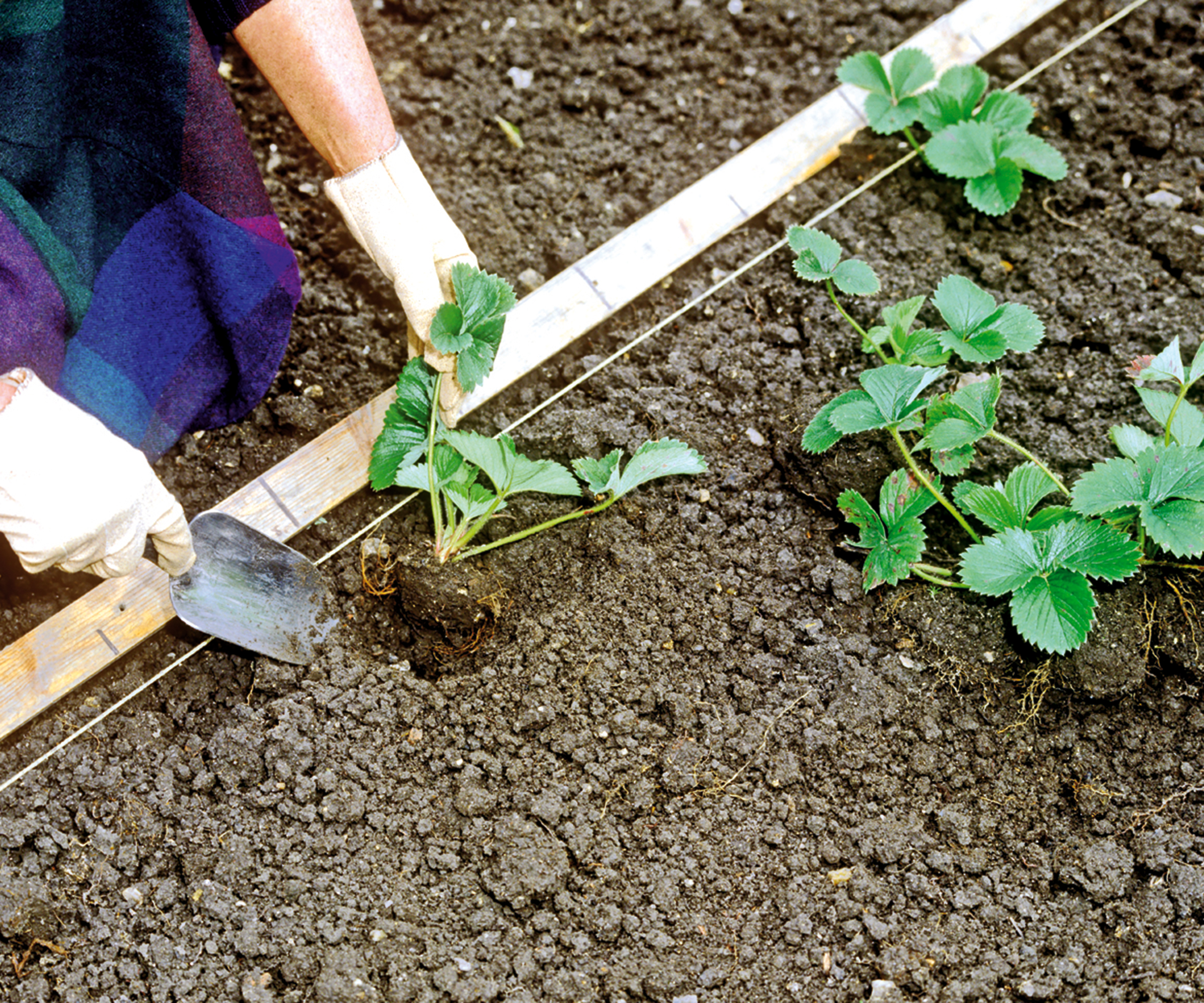
When To Plant Strawberries
The best time to plant strawberries is in late summer to early fall, enabling them to become established and produce a generous crop the following year.
However, they also do well planted on a cloudy day in March or April, as soon as the ground is workable. This gives the plants time to settle into their plot before warm weather arrives.
Where To Plant Strawberries
Strawberry plants need full sun so choose a bright spot where they’ll have six or more hours of full sun exposure.
The amount of sun your plants get will determine the size of the crop and the size of the berries.
Additionally, many varieties produce blossoms in early spring that can be killed by a late frost unless there’s plenty of sun on your plants.
Strawberry Plant Spacing
Ideally strawberry plants should be spaced 1.5 to 2 feet apart (40 to 60cm) to allow plenty of room for them to grow and spread. However, where space is tight, you can go as close as 1 foot (31cm) if you keep on top of watering and fertilizing.
If planting strawberries in rows, leave 3 to 4 feet (about 1m) between rows.

How To Grow Strawberries From Seeds
Growing strawberries from seeds is an option, but it is a slow process, taking around a year before the plants are capable of bearing fruit.
If you are considering collecting seed to grow strawberries, bear in mind that the plants are hybrids, so fruits won’t come true from seed unless they are wild strawberries or open-pollinated varieties. However, some gardeners enjoy experimenting with the idea of creating new varieties.
If you grow alpine strawberries, these will need to be propagated from seed.
To grow strawberries from seeds:
- In spring or fall, sow strawberry seeds into a container filled with seed-starting potting mix. The container must have drainage holes.
- Sprinkle the seeds thinly across the surface, and lightly press them into the potting mix, but don’t add more compost.
- Cover the container with plastic wrap and place the container on a bright windowsill, or use a grow light set to run for 12-14 hours a day.
- Once the seeds have germinated (this might take up to six weeks), feed the plants every two weeks with weakly diluted fertilizer (half the usual strength).
- When the seedlings become more established, thin them out and transplant into individual pots, then begin fertilizing at full strength.
- After around 6 weeks, begin to acclimatize the seedlings to outdoors by placing them in a sheltered position. Start with just a couple of hours each day, then gradually increasing the amount, moving them to a sunny spot.
- When they are acclimated to being outdoors conditions, plant the seedlings in an area with full sun, in well-draining, slightly acidic soil. Mix in some fertilizer before planting.
- Water the plants in well and mulch around them with straw, which will help to retain water and prevent the fruits from sitting on bare soil.
Best Soil For Strawberries
Rich, fertile, slightly acidic soil with a pH level of 5.7 to 6.5 is perfect for growing strawberries. It should also be well draining.
Whatever your soil type, you should improve it with compost, well-rotted manure, or other organic matter before planting.
If your soil type is not suitable, then growing strawberries in raised beds or containers is a better solution, as you can control the soil mix.
Watering Strawberries
When learning how to grow strawberries, it is watering that often leads to most confusion.
Due to the plants’ shallow roots, strawberries need to be watered regularly. If you live in an area with regular rainfall, then much of this can be supplied naturally. However, most gardeners will find that watering strawberries is necessary in dry weather.
Avoid watering from overhead, as the leaves don’t like to be soggy. Water the soil rather than the plants. Drip or soaker hoses placed nearby work best.

How Often To Water Strawberries?
Strawberries should be watered at least once a week, but in dry periods the frequency will need to increase. When growing strawberries in high heat, you may find you need to water your strawberries every day.
Rather than watering on a schedule, check to feel whether the soil is dry. To do this, push your finger two inches deep into the soil. If it feels dry, then it’s time to water. If it feels moist, then hold off. Overwatering can quickly lead to rot.
How Much Water Do Strawberries Need?
Whether provided manually or naturally via rainfall, strawberries need about 1 to 2 inches (2.5 to 5cm) of water each week.
During dry, hot weather, this can be increased to 2.5 inches (6cm) each time you water. Check daily to see whether the soil is dry.
Fertilizing Strawberries
Fertilizing strawberries is essential to a good harvest of juicy strawberries. When plants are producing green growth in the spring and late fall, they require nitrogen. This can be provided by amending the soil before planting with compost or manure.
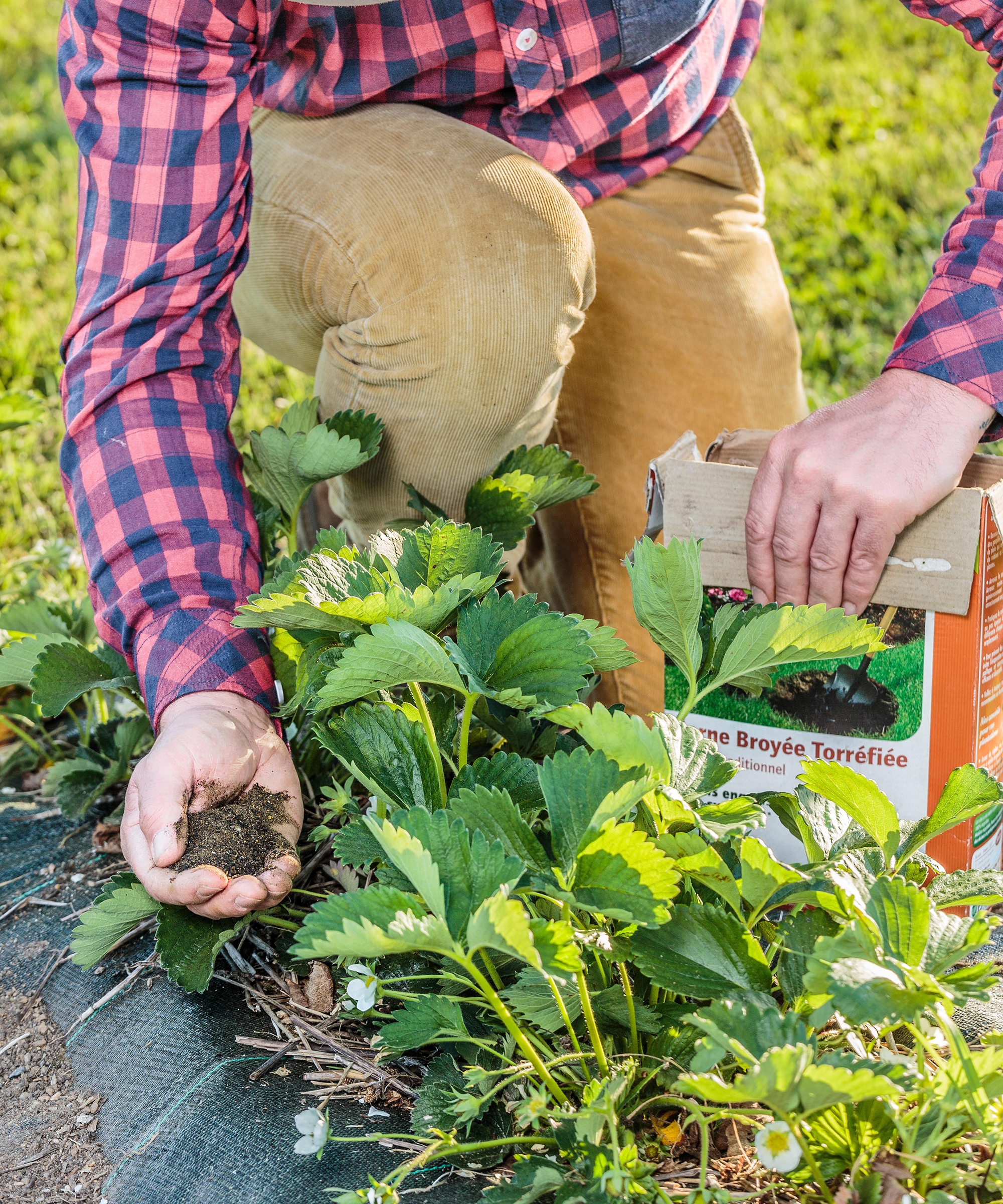
When To Fertilize Strawberries
When you notice strawberry plants have begun to put on new growth, it’s time to feed them with a balanced fertilizer. This usually happens between early and mid spring.
Fertilize strawberries for a second time after they have finished fruiting. This will give plants the boost they need to send out runners and to store energy for growing a bumper crop the following summer.
How To Fertilize Strawberries
Use a commercial 10-10-10 fertilizer, which contains equal parts of nitrogen, phosphorus, and potassium.
As a general guide, use 1 pound (454g) of fertilizer per 20-foot (6m) row of strawberries. Apply the fertilizer around the base of each plant and water in well.
Alternatively, you can use organic fertilizers, such as blood meal, fish meal, or alfalfa meal.
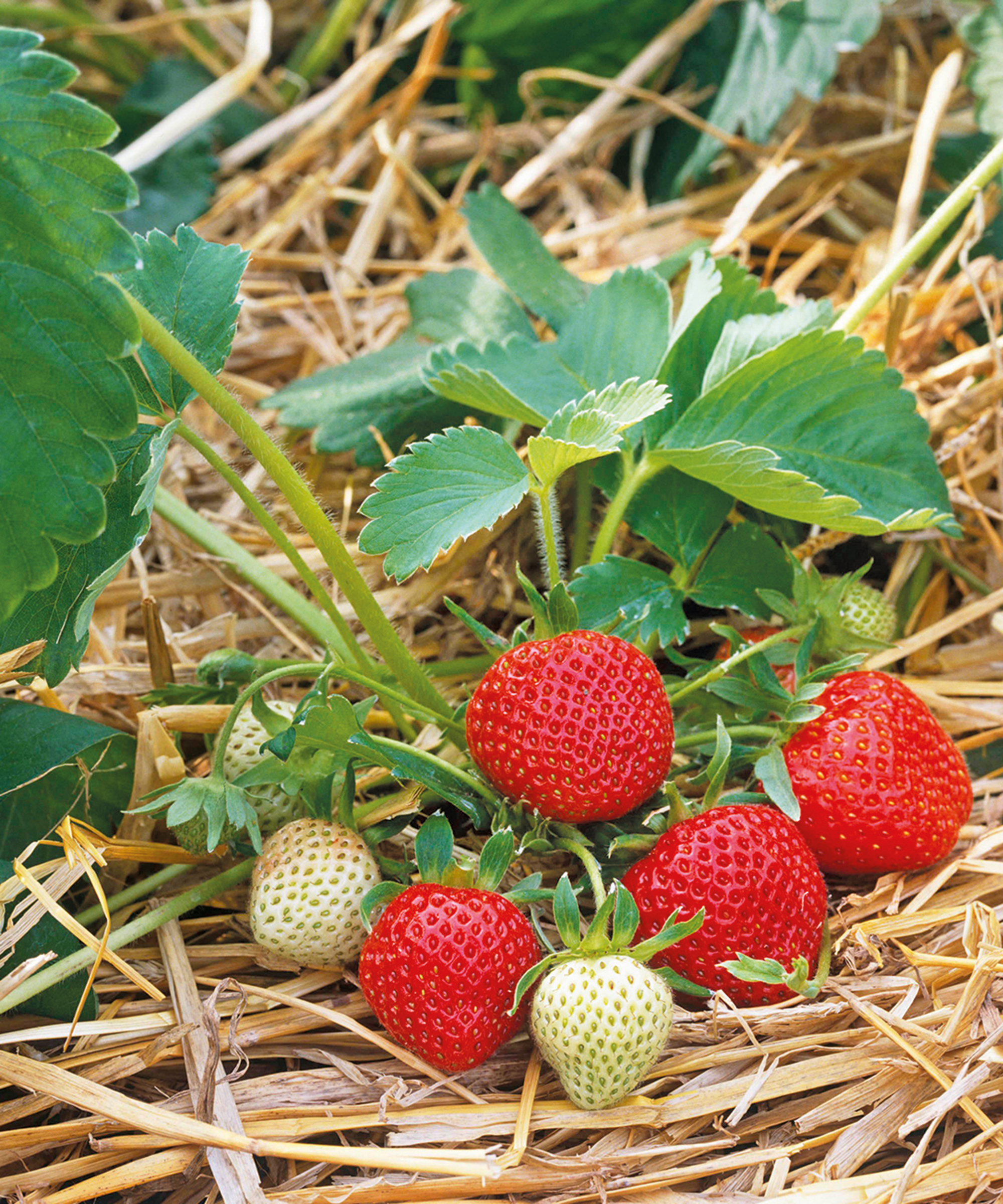
Mulching Strawberries
Mulching strawberries has several benefits and should be done once or twice a year.
In the spring, applying a thin layer of straw mulch around strawberry plants – at a depth of about 1 inch (2.5cm) – will help to retain soil moisture and prevent the fruit from sitting directly upon bare soil. Tucking in cardboard or felt matting will also do the trick.
In climates with cold winters, it is best to winterize strawberries by applying mulch on top of the plants in late fall or early winter to protect them from extreme temperatures.
Wait until the foliage flattens before mulching, as strawberries that are exposed to the first hard autumn frost will be more productive come summer.
Remove this layer of mulch in early spring before applying a fresh, thin layer underneath the foliage.
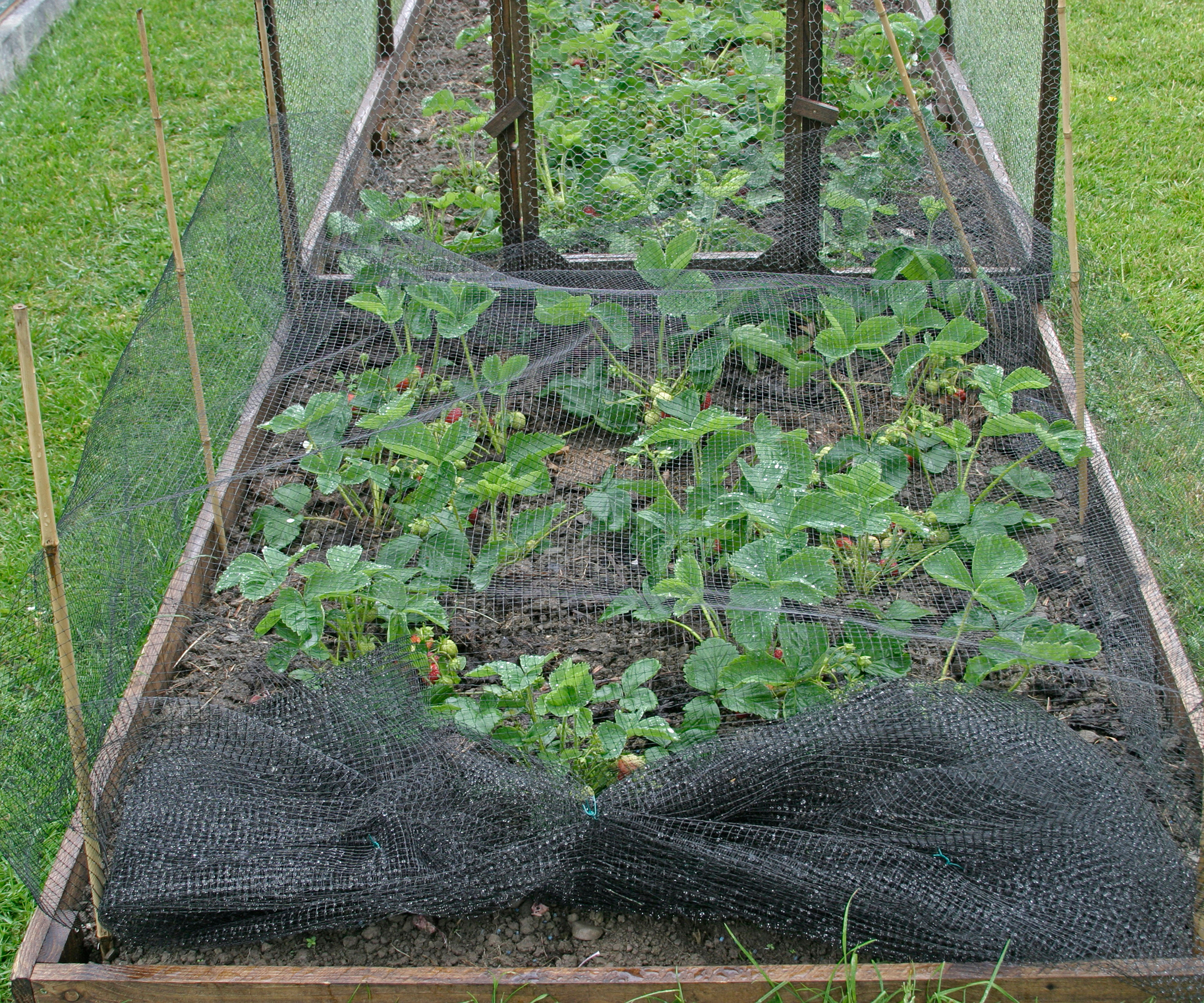
Protecting Strawberries From Birds
Berries are a popular snack for birds, who can quickly ravage a strawberry patch. As soon as any of the green fruits begin to turn red, cover strawberries with a net.
This can be held in place by canes, and should be easy to roll back when it’s time to harvest your strawberries.

How To Pick Strawberries
Strawberries should be picked when they are completely red, as they won’t continue to ripen after harvesting. Berries will ripen at different times, so check over your plants every two to three days. The best time to pick them is in the morning, when the berries are cool.
When picking strawberries, leave about a quarter of the stem attached, taking care not to bruise the flesh. The best method is to hold the stem between your forefinger and thumbnail, then gently pull and twist.
Ideally, eat them the same day, but they will keep in a refrigerator for three days. If you have a glut then there are many delicious uses for fresh strawberries from the garden.
How To Prune Strawberries
Once you have finished harvesting the last strawberries of the season, you need to prune back the plants’ foliage to 3 to 4 inches (7.5 to 10cm) above the crown.
This will enable the plants to put their energy to strengthening their roots and putting out new growth in time for next year.
At the same time as pruning, thinning out strawberries to get rid of old plants will help to make the plot more productive. Replace them with runners grown from the older plants.
Use sharp, sterilized hand pruners to avoid damaging the plants or transferring disease.
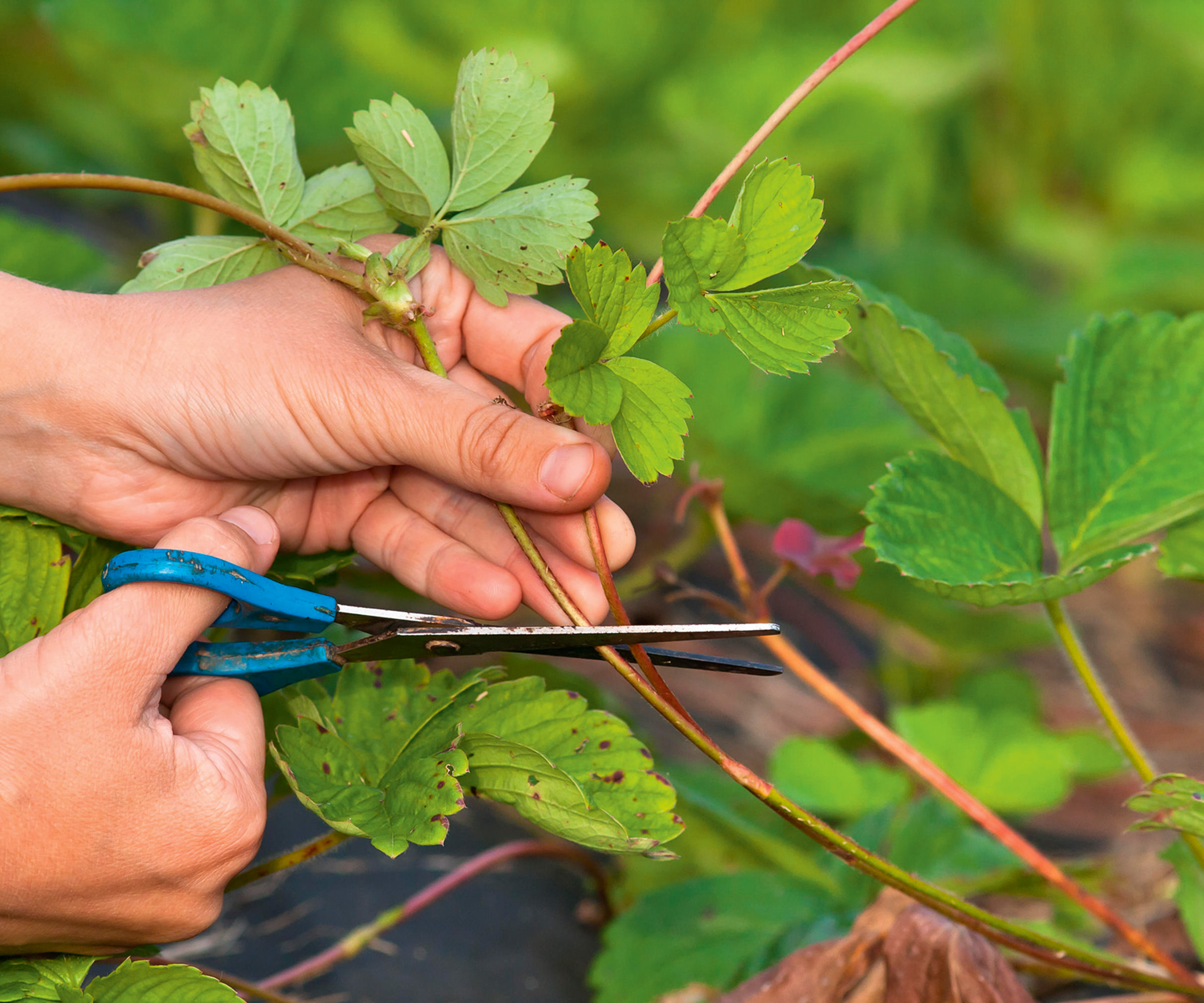
How To Propagate Strawberries
Propagating strawberries from runners is so easy to do. Each strawberry plant usually sends out several runners, which can become baby plants. These will keep your strawberry patch going for years to come, and you will likely have enough plants to give some as gifts.
In late summer or fall, once the plants have finished for the season, gently prize each runner away from the main plant. Keep the closest runners to the plant for propagating, as these are the strongest. Those furthest away can be discarded.
These runners can be left in place to form their own plants, or ideally should be transferred to individual pots, for planting out in the spring.
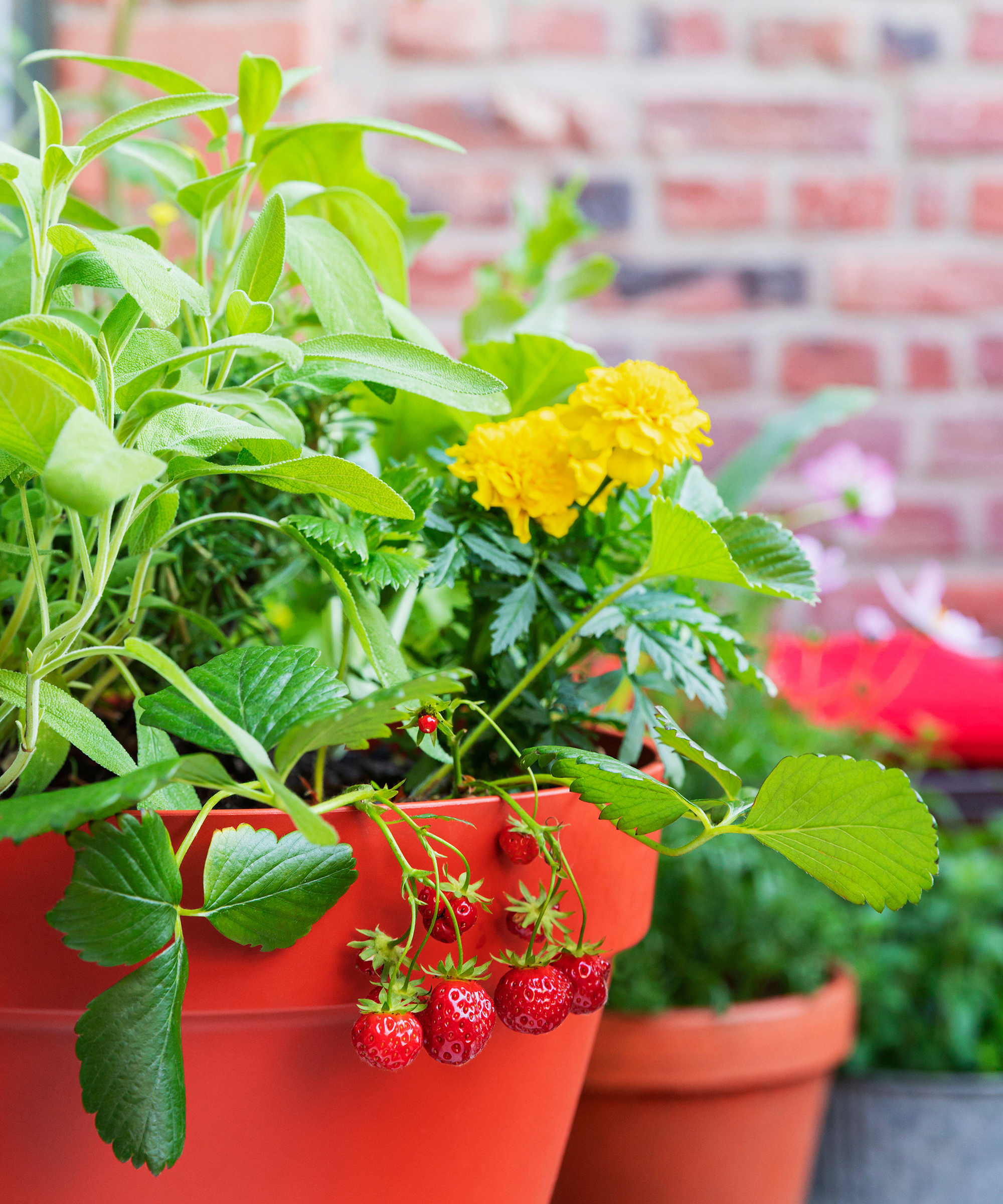
Strawberry Companion Plants
Companion planting is an age-old practice of positioning plants close to each other where they offer benefits. Strawberry companion plants can help by deterring pests, providing shade, serving as living mulch, and even improving flavor.
What to plant with strawberries:
- Herbs such as borage, thyme, dill, coriander, mint, and sage repel certain pests. They also attract pollinators and beneficial insects that eat soft-bodied pests such as aphids, thrips, scale, and caterpillars. Some herbs, such as borage, can even strengthen strawberry plants’ resistant to disease and make the fruits taste sweeter.
- Beans naturally fix nitrogen in the soil, providing fertilizer for other crops.
- Garlic and onions produce an odor that repels many pests. Planting them close to strawberries can reduce the chance of plants being feasted on.
- Lettuce and spinach interplanted with strawberries can enhance the productivity of all three plants. Additionally, the leaves can help to hide the fruits from birds.
- French marigolds are ideal companions for strawberries, as they produce a strong odor that discourages pests such as greenfly and blackfly. They are also believed to repel root knot nematodes, which can severely damage the roots of strawberry plants.
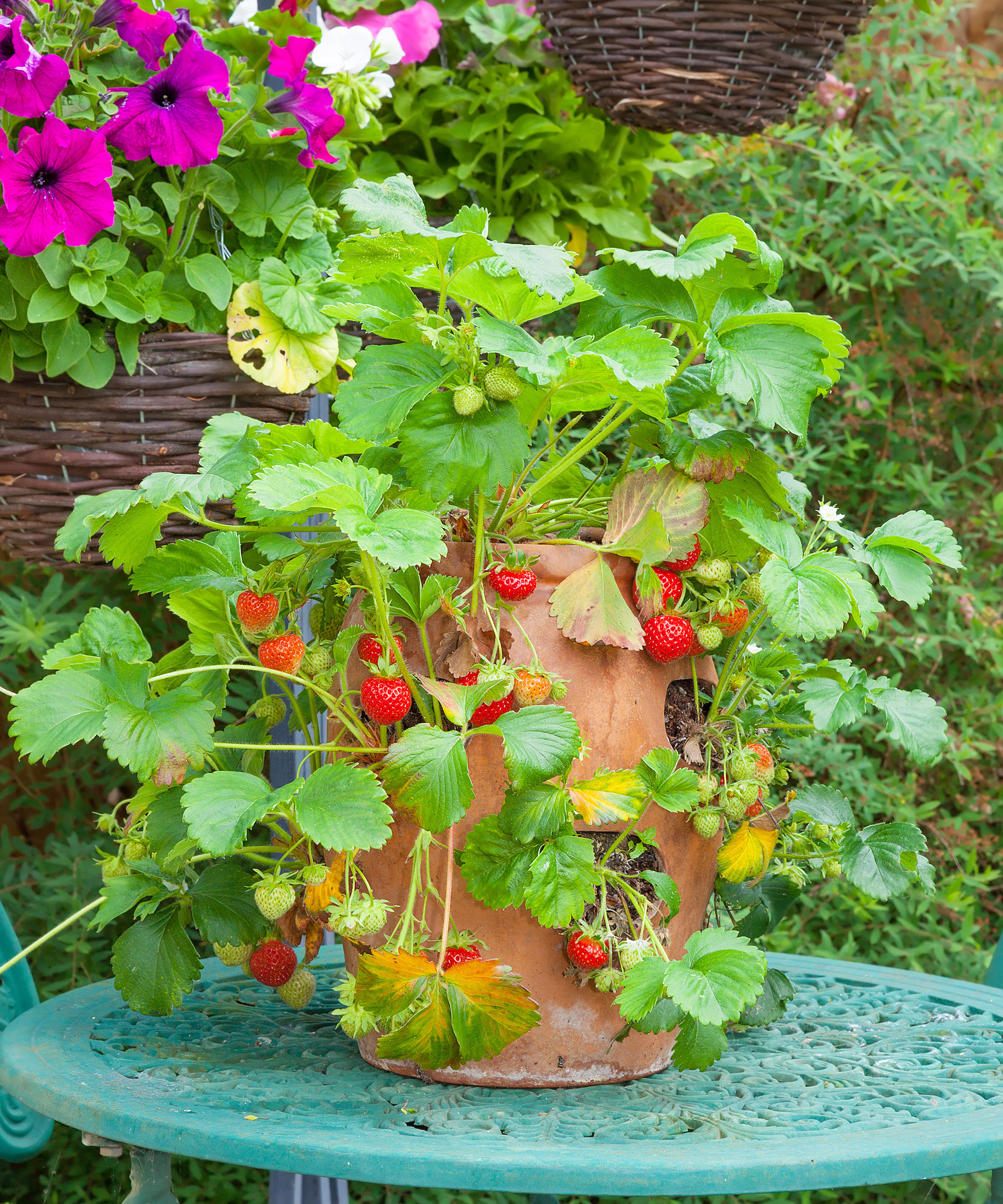
Growing Strawberries In Containers
Strawberries are ideal container plants, and can be grown in pots on a patio, or even in a hanging strawberry planter, as long as they are positioned to receive plenty of sunlight.
When growing strawberries in containers, ideally choose a tiered planter with holes in the side for growing individual plants. This format allows the berries to hang down, rather than sitting on top of soil. However, any containers can be used – including grow bags – as long as they have plenty of drainage holes, so that the soil doesn’t get soggy.
To plant up a tiered strawberry container, you will need one plant for each hole, and three of four at the top.
Other containers will be able to accommodate three to four plants, depending on size.
Add broken pieces of terracotta to the base of your pot to aid drainage, then fill with your growing medium. Either purchase bags of soil designed for growing fruits and vegetables, or make your own mix using a blend of soil, homemade compost, and soilless media to promote drainage, such as perlite or vermiculite. Mix in a slow-release fertilizer.
If planting a tiered pot, add the growing medium gradually, adding in the plants as you go.
Position your container in a sunny spot and water well. Bear in mind that strawberries grown in containers will require more regular watering and fertilizing than when grown in the ground.
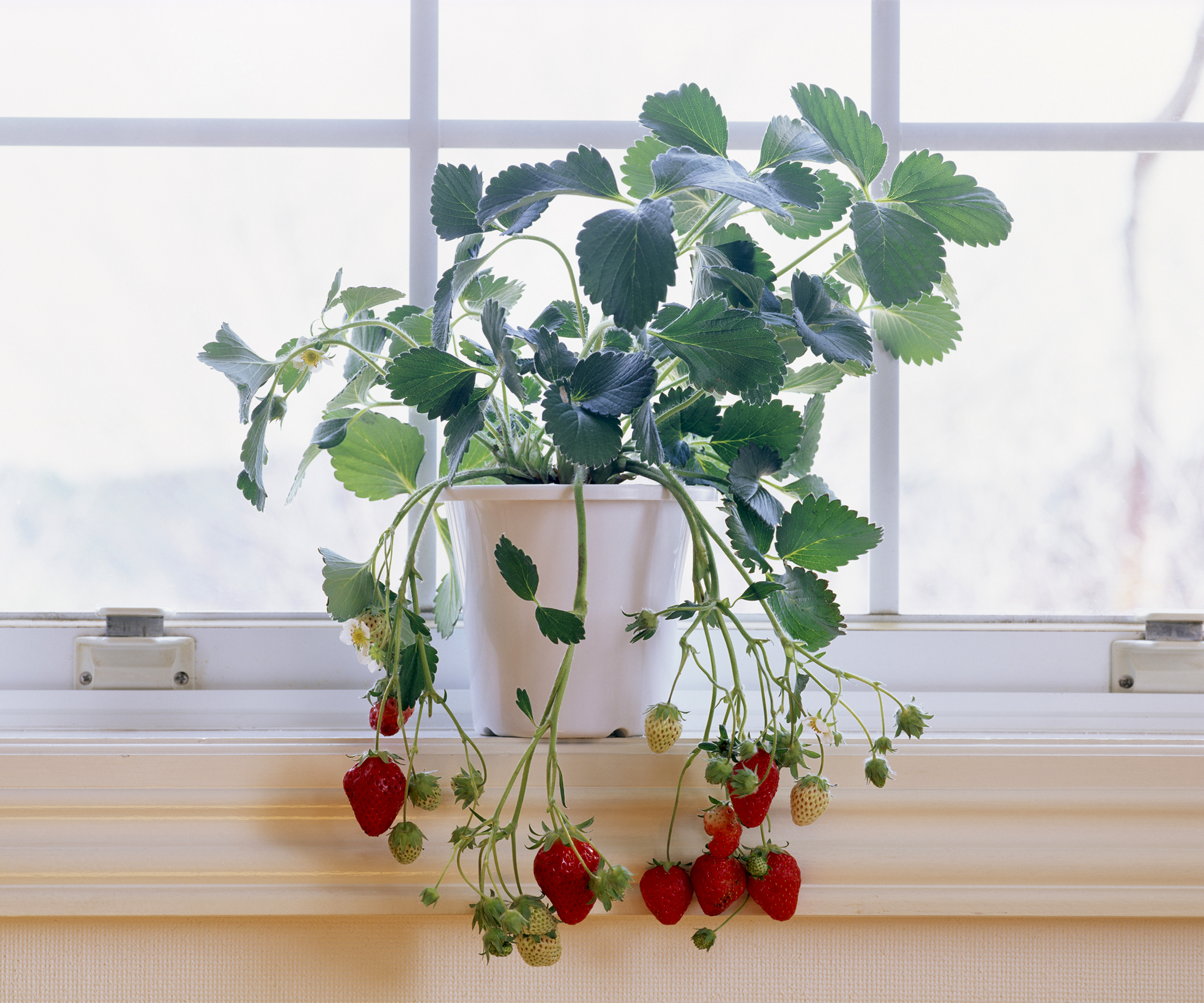
Growing Strawberries Indoors
Growing strawberries indoors is possible where there is no outdoor space, and may even be the preferred option in some climates.
The main challenge is getting enough light for the plants, as they require at least six hours of sun per day.
If lining them up on a sunny windowsill doesn’t provide enough light, then invest in a growing light.
Strawberries planted indoors are likely to be in smaller containers, so it’s important to check soil moisture every day.
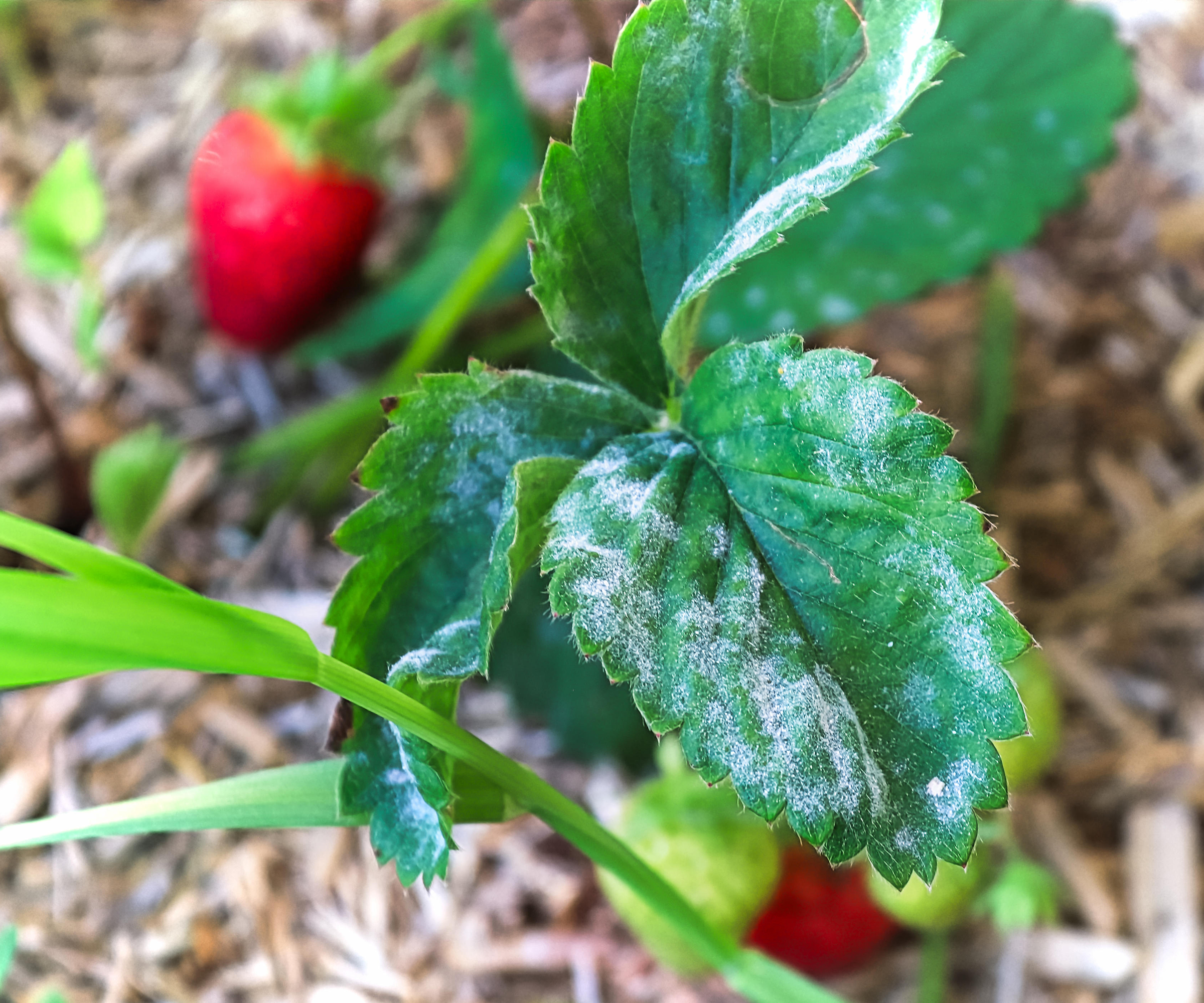
Problems & Pests
When learning how to grow strawberries, it is disheartening when plants have problems. But if you take time to diagnose and solve the issue you may still enjoy a bountiful harvest.
Protecting strawberries from insects will minimize issues. Clever companion planting should be your starting point, but where strawberry plant pests are present, organic control solutions can be employed.
If not dealt with swiftly, these common strawberry plant problems could lead to a poor crop or even plant death:
- Strawberry plant leaves curling up is usually caused by lack of watering or temperature extremes, but may be a nutrient deficiency.
- Strawberry plant leaves turning brown are most commonly caused by improper watering. However, when accompanied by other symptoms, it could be a sign of disease.
- Yellow leaves on strawberry plants are most likely caused by a nutrient deficiency, so ensure you use a balanced fertilizer.
- Red leaves on strawberry plants may be caused by a fungal infection such as red stele disease or strawberry leaf scorch. Buying disease-resistant varieties, and practicing good crop rotation, plant spacing, sanitation, and watering practices will help to miminize the risk.
- Strawberry black root rot is a serious disease that initially presents itself through stunted runners, and small berries. When roots are exposed they will be black or have black patches. Check plants have healthy white roots before planting. Where the disease is present, destroy affected plants and do not plant new strawberries on the same site.
- Cercospora leaf spot on strawberries is a fungal disease that impacts plant health and yield. It presents itself with small purple spots on the leaves, which eventually turn tan to whitish gray at the centers with purple edges. Leaf drop may also occur. To prevent leaf spot, keep beds free from weeds, observe proper plant spacing, water the soil rather than the leaves, and apply a fungicide at blossom time.
- Deformed strawberries are usually edible, but may look less palatable. Possible causes are lack of pollination, frost damage, and nutrient deficiency.
- Mold on strawberry plants may be caused by botrytis rot, which is a serious fungal disease. It thrives in damp and is carried over from the previous year’s growth. To avoid it, keep on top of weeds and clear away any detritus before the plants begin to grow in the spring. Plant strawberries in a spot with good drainage and air circulation.
- Strawberry powdery mildew is a mold-like fungal infection that can cause poor fruits. Where present, prune out affected leaves and apply a fungicide. To prevent powdery mildew, plant strawberries in a sunny spot with good air circulation.
- Strawberry anthracnose is a destructive disease that overwinters on plant debris and is harbored by weeds. The spores are then spread mostly through water splashing off affected plants. It impacts the entire plant, which may wilt and die. Lesions may be present on fruit. Anthracnose spreads quickly and can wipe out entire crops. To avoid it, plant only disease-resistant cultivars and water the soil, avoiding the plants. Remove and destroy affected plants as soon as you spot them.
- Strawberry plant wilting could be caused by lack of watering, or it could be caused by something more sinister, such as strawberry verticillium wilt. Infected plants will be unlikely to live to produce fruit. Soil fumigation is the best measure, but is expensive. In general gardeners should practice good crop rotation and avoid planting strawberries in areas previously affected.
- When strawberries aren’t sweet, it could be due to poorly enriched, incompatible soil.
- Strawberries rotting on the vine is usually due to a fungal infection. These thrive in excessive moisture and warm, humid weather, especially where there is poor air circulation around plants.
- No fruit on strawberry plants and strawberry plants not flowering can be caused by improper fertilizing, underwatering, pests, or disease.
- Ants on strawberry plants may be due to the presence of a pest such as aphids or scale bugs.
Frequently Asked Questions
How many strawberry plants per person?
On average, six plants per person will yield a satisfying amount of strawberries. However, don't let a lack of space put you off – just grow what you can and savor what you manage to harvest.
If you have ambitions of making preserves, then you will need more plants.
You can expect a healthy plant to yield about a quart of strawberries per year, but this will not be all at once.
Are strawberry plants perennials?
Strawberry plants are short-lived perennials, and will only stay productive for around three years. At this stage, you should replace plants with new runners propagated from the parent plants.
Do strawberry plants need full sun?
Most strawberry varieties require a minimum of six hours of direct sun exposure each day. However, there are some shade-tolerant strawberries that can be grown. These tend to be wild strawberries.
How long do strawberries take to grow?
It takes around three months for newly planted strawberry plants to bear fruit. However, it takes a lot longer when plants are grown from seed – up to a year.
Should I pinch off strawberry flowers?
Pinching off strawberry flowers is not essential. However, removing the first blossoms can help the plants make better, bigger berries the following year.
If you decide to do this, pinch off all the blossoms from your June-bearing plant during its first growth season and remove blossoms from everbearing plants until early July. After these first rounds of blossoms are taken off, the plants will produce luscious berries.

Melanie is an experienced gardener and has worked in homes and gardens media for over 20 years. She previously served as Editor on Period Living magazine, and worked for Homes & Gardens, Gardening Etc, Real Homes, and Homebuilding & Renovating. Melanie has spent the last few years transforming her own garden, which is constantly evolving as a work in progress. She is also a passionate organic home grower, having experimented with almost every type of vegetable at some point. In her home, Melanie tends to an extensive houseplant collection and is particularly fond of orchids.